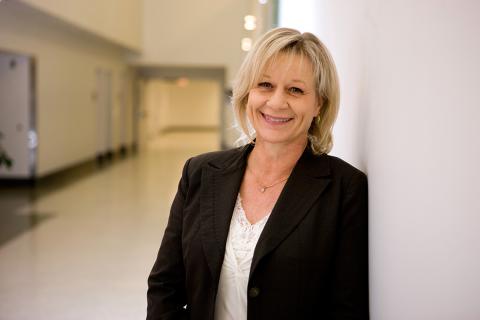Therapies Foreseen
Bakaletz Shows How to Bust a Biofilm

It was while Dr. Lauren Bakaletz and her team were trying to create a vaccine for otitis media—the middle-ear infection familiar to most new parents and a significant cause of deafness in the developing world—that they happened upon the technology to disrupt biofilms.
What are biofilms, you ask? They are not movies shown to high school sophomores during science class, but crafty little living blankets prone to setting up residence on any surface, such as the bones of the middle ear (a biotic surface) or on the metallic surface of your newly replaced hip joint (abiotic surface).
Brawnier than blankets, though, biofilms act as a kind of shield, protecting bacteria embedded within them. “Resident bacteria in a biofilm are typically 1,000-fold more resistant to antibiotics than their free-living counterparts,” Bakaletz said.
“[Biofilm-associated infections] are very common, they are very complex and they are very difficult to treat,” said Bakaletz, professor of pediatrics and otolaryngology, vice president for basic sciences and director of the Center for Microbial Pathogenesis at the Research Institute at Nationwide Children’s Hospital in Columbus, Ohio. She gave the Wednesday Afternoon Lecture recently in Masur Auditorium.
“Any device put in the body is prone to biofilm development,” she continued. Biofilms are also associated with sinusitis, chronic urinary tract infection and wound infections.
Bakaletz has spent her entire career studying otitis media (OM), an ailment that typically recruits commensal bacteria found in a person’s nasopharynx. Worldwide, there are 709 million new OM cases yearly, with 21,000 deaths, usually due to meningitis. There are more than 330 million cases annually of chronic suppurative OM (CSOM), resulting in some 50,000 deaths, usually to children under age 5. CSOM is associated with more than 50 percent of hearing loss worldwide, with disease burden mostly borne by those in developing countries.
As moms and dads everywhere know, antibiotics—“pink medicine”—are the most common treatment for OM, but prolonged use of antibiotics gives rise to antibiotic-resistant strains of bacteria, compounding an already significant public health problem.
Biofilms are behind both OM and otorrhea, the drainage exiting an infected person’s ear, Bakaletz said. And behind the persistence of biofilms is the EPS—extracellular polymeric substance, or matrix—that surrounds and supports the bacteria within a biofilm. It is a kind of armor protecting the bugs that make us sick.

Photo: Savushkin/Getty
The gold standard for studying OM in animals is the chinchilla. The bony septae within the animal’s ears provide a natural depth gauge for measuring deposits of the hardy, pulpy white substance that proves so difficult to clear with antibiotics.
It is the mucosa of the middle ear upon which these living films take up residence and play their role in the recurrence and chronicity of OM.
Bakaletz and her colleagues took a deep dive into the matrices and bacteria that form biofilms and found that they are characterized by an abundance of extracellular DNA (eDNA) and associated DNA-binding proteins (especially DNABII). They found “a tremendous lattice of cross-hatched DNA,” indicating that biofilms enshroud and protect the bacteria upon which they form. DNABII “serve as linchpins of the lattice, to stabilize eDNA,” she said.
The researchers found similar lattices in wounds forming after cesarean section and from the sputum of children with cystic fibrosis.
They wondered: Could anti-DNABII antibodies collapse the lattice, thereby resolving the infection?
Studies employing that strategy revealed a reduction of more than 86 percent in the thickness and biomass of the biofilm in vitro. Further, Bakaletz believes the technology developed by her team can disrupt many biofilms, not just those created by nontypeable Haemophilus influenzae, the bacterium at the root of chronic and recurrent childhood cases of OM.
An ancillary benefit of inducing lattice-collapse is that standard antibiotics suddenly work more robustly than ever, with 4 to 8 times better efficiency, Bakaletz reported. Stripped of the protection of the matrix, free bacteria are more easily eliminated.
“So we can use [antibiotics] at a lower dose” when they are applied synergistically with the collapse-inducing antibodies.
Also intriguing is that only 8 to 12 percent of the bacterial cells within a population were releasing the eDNA and DNABII proteins targeted by anti-DNABII antibodies, yet aiming at this target was “enough for a cure.”
Bakaletz and her collaborators, encouraged by early success in developing a therapeutic immunization regimen in chinchillas, now believe they can spur the development of antibodies that can resolve other human diseases, not just OM.
Their painstaking work developing chimeric peptide immunogens targeting the tips and tails of bacterial cells has revealed that anti-tip chimeric Fab fragments are the most effective therapeutic in their studies, to date.
“What is the human response to these proteins?” she wondered, noting that this is important to know as part of her team’s assessment of them for use in clinical trials. One OM trial envisions transcutaneous vaccine delivery via a kind of band-aid placed behind the ear.
Funded for her entire career by the National Institute on Deafness and Other Communication Disorders, Bakaletz concluded, “I hope there is a clinical use for our observations.”
During a brief Q&A, she noted that cystic fibrosis is among the diseases short-listed for future trials employing DNABII-targeted therapy. She predicts benefits will likely extend to implanted medical devices, as well as to animals, including pets and livestock.
